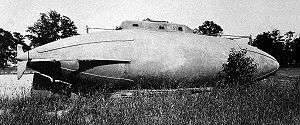Fenian Ram
 Fenian Ram at the New York State Marine School some time between 1916 and 1927 | |
| History | |
|---|---|
| Name: | Holland Boat No. II |
| Owner: | Fenian Brotherhood |
| Builder: | DeLamater Iron Works, New York City |
| Launched: | 1881 |
| Nickname(s): | Fenian Ram |
| Status: | Museum ship |
| General characteristics | |
| Type: | Submarine |
| Displacement: | 19 long tons (19 t) |
| Length: | 9.4 m (30 ft 10 in) |
| Beam: | 1.8 m (5 ft 11 in) |
| Height: | 1.8 m (5 ft 11 in) |
| Propulsion: | 1 × 15 hp (11 kW) Brayton piston engine, single screw |
| Test depth: | 18 m (59 ft) |
| Complement: | 3 (operator, engineer, gunner) |
| Armament: | 1 × 9 in (230 mm) pneumatic gun |
Fenian Ram is a submarine designed by John Philip Holland for use by the Fenian Brotherhood, American counterpart to the Irish Republican Brotherhood, against the British. The Ram's construction and launching in 1881 by the Delamater Iron Company in New York was funded by the Fenians' Skirmishing Fund. Officially Holland Boat No. II, the role of the Fenians in its funding led the New York Sun newspaper to name the vessel the Fenian Ram.[1]
Design
Fenian Ram's design was partly modelled on the Whitehead torpedo, and like it had cruciform control fins near the tail. The boat did not simply take on ballast until she sank like other contemporary submarines; she maintained a slightly positive buoyancy, and simply tilted her horizontal planes so that her forward motion forced her under.
Fenian Ram was armed with a nine-inch pneumatic gun some eleven feet long, mounted along the boat's centerline and firing forward out of her bow. It operated like modern submarine torpedo tubes: a watertight bow cap was normally kept shut, allowing the six-foot-long dynamite-filled steel projectiles to be loaded into the tube from the interior of the submarine. The inner door was then shut and the outer door opened by a remote mechanism. Finally, 400 psi (2.8 MPa) air was used to shoot the projectile out of the tube. To reload, the outer door was again shut and the water in the tube was blown into the surrounding ballast tank by more compressed air. It was powered by a 15 hp (11 kW) Brayton piston engine.[2]
Ship history
_images_(45)_number_36_Early_submarine.jpg)
During extensive trials, Holland made numerous dives and test-fired the gun using dummy projectiles. However, due to funding disputes within the IRB and disagreement over payments from the IRB to Holland, the IRB stole Fenian Ram and the Holland III prototype in November 1883.[3] They took the submarine to New Haven, Connecticut, but discovered that no one knew how to operate it. Holland refused to help. Unable to use or sell the boat, the Brotherhood had the Ram hauled into a shed on the Mill River.
In 1916, Fenian Ram was exhibited in Madison Square Garden to raise funds for victims of the Easter Rising. Afterwards, she was moved to the New York State Marine School. In 1927, Edward Browne purchased her and moved her to Paterson, New Jersey, where she can still be seen at the Paterson Museum.
References
- ↑ "John Holland Father of the Modern Submarine". navy.mil. 2006. Retrieved 28 August 2012.
- ↑ Maloney, William (2012). "Holland Submarine Exhibit, Fenian Ram and Submarine No. 1, Paterson Museum N.J.". williammaloney.com. Retrieved 28 August 2012.
- ↑ Davies, R. Nautilus: The Story of Man Under the Sea. Naval Institute Press. 1995. ISBN 1-55750-615-9.
External links
- The John Holland Website
- Fenian Ram Photos of John Holland's Submarine Fenian Ram at the Paterson Museum in Paterson, NJ
- Paterson Museum The Paterson Museum Website
- HNSA Web Page: Fenian Ram
Coordinates: 40°54′49″N 74°10′45″W / 40.91371°N 74.17923°W